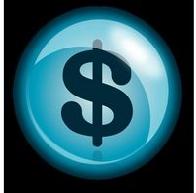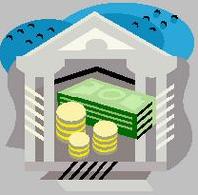
 |
|
| Financial Terms | |
| Residuals |
|
Information about financial, finance, business, accounting, payroll, inventory, investment, money, inventory control, stock trading, financial advisor, tax advisor, credit.
Main Page: stock trading, investment, accounting, tax advisor, inventory control, credit, inventory, money, |
Definition of Residuals
Residuals1) Parts of stock returns not explained by the explanatory variable (the market-index return). They
Related Terms:CARs (cumulative abnormal returns)a measure used in academic finance articles to measure the excess returns an investor would have received over a particular time period if he or she were invested in a particular stock. DLOM (discount for lack of marketability)an amount or percentage deducted from an equity interest to reflect lack of marketability. NPV (net present value of cash flows)Same as PV, but usually includes a subtraction for an initial cash outlay. PPF (periodic perpetuity factor)a generalization formula invented by Abrams that is the present value of regular but noncontiguous cash flows that have constant growth to perpetuity. PV (present value of cash flows)the value in today’s dollars of cash flows that occur in different time periods. QMDM (quantitative marketability discount model)model for calculating DLOM for minority interests r the discount rate Abnormal returnsPart of the return that is not due to systematic influences (market wide influences). In  Acquisition of stockA merger or consolidation in which an acquirer purchases the acquiree's stock. Adjustable rate preferred stock (ARPS)Publicly traded issues that may be collateralized by mortgages and MBSs. Affirmative covenantA bond covenant that specifies certain actions the firm must take. After-tax real rate of returnMoney after-tax rate of return minus the inflation rate. American Stock Exchange (AMEX)The second-largest stock exchange in the United States. It trades Annual fund operating expensesFor investment companies, the management fee and "other expenses," Annualized holding period returnThe annual rate of return that when compounded t times, would have Arithmetic average (mean) rate of returnArithmetic mean return. Arithmetic mean returnAn average of the subperiod returns, calculated by summing the subperiod returns  Arms indexAlso known as a trading index (TRIN)= (number of advancing issues)/ (number of declining Auction marketsmarkets in which the prevailing price is determined through the free interaction of Auction rate preferred stock (ARPS)Floating rate preferred stock, the dividend on which is adjusted every Average accounting returnThe average project earnings after taxes and depreciation divided by the average Average collection period, or days' receivablesThe ratio of accounts receivables to sales, or the total Average (across-day) measuresAn estimation of price that uses the average or representative price of a Average rate of return (ARR)The ratio of the average cash inflow to the amount invested. Balanced fundAn investment company that invests in stocks and bonds. The same as a balanced mutual fund. Balanced mutual fundThis is a fund that buys common stock, preferred stock and bonds. The same as a Bear marketAny market in which prices are in a declining trend. Beta (Mutual Funds)The measure of a fund's or stocks risk in relation to the market. A beta of 0.7 means  Beta equation (Mutual Funds)The beta of a fund is determined as follows: Beta equation (Stocks)The beta of a stock is determined as follows: Black marketAn illegal market. Bond indexingDesigning a portfolio so that its performance will match the performance of some bond index. Brady bondsbonds issued by emerging countries under a debt reduction plan. Brokered marketA market where an intermediary offers search services to buyers and sellers. Bull marketAny market in which prices are in an upward trend. Bulldog marketThe foreign market in the United Kingdom. Buying the indexPurchasing the stocks in the S&P 500 in the same proportion as the index to achieve the Capital marketThe market for trading long-term debt instruments (those that mature in more than one year). Capital market efficiencyReflects the relative amount of wealth wasted in making transactions. An efficient Capital market imperfections viewThe view that issuing debt is generally valuable but that the firm's Capital market line (CML)The line defined by every combination of the risk-free asset and the market portfolio. CashThe value of assets that can be converted into cash immediately, as reported by a company. Usually Cash budgetA forecasted summary of a firm's expected cash inflows and cash outflows as well as its Cash and carryPurchase of a security and simultaneous sale of a future, with the balance being financed Cash and equivalentsThe value of assets that can be converted into cash immediately, as reported by a Cash commodityThe actual physical commodity, as distinguished from a futures contract. Cash conversion cycleThe length of time between a firm's purchase of inventory and the receipt of cash Cash cowA company that pays out all earnings per share to stockholders as dividends. Or, a company or Cash cycleIn general, the time between cash disbursement and cash collection. In net working capital Cash deficiency agreementAn agreement to invest cash in a project to the extent required to cover any cash Cash deliveryThe provision of some futures contracts that requires not delivery of underlying assets but Cash discountAn incentive offered to purchasers of a firm's product for payment within a specified time Cash dividendA dividend paid in cash to a company's shareholders. The amount is normally based on Cash equivalentA short-term security that is sufficiently liquid that it may be considered the financial Cash flowIn investments, it represents earnings before depreciation , amortization and non-cash charges. Cash flow after interest and taxesNet income plus depreciation. Cash flow coverage ratioThe number of times that financial obligations (for interest, principal payments, Cash flow from operationsA firm's net cash inflow resulting directly from its regular operations Cash flow matchingAlso called dedicating a portfolio, this is an alternative to multiperiod immunization in Cash flow per common sharecash flow from operations minus preferred stock dividends, divided by the Cash flow time-lineLine depicting the operating activities and cash flows for a firm over a particular period. Cash-flow break-even pointThe point below which the firm will need either to obtain additional financing Cash management billVery short maturity bills that the Treasury occasionally sells because its cash Cash marketsAlso called spot markets, these are markets that involve the immediate delivery of a security Cash offerA public equity issue that is sold to all interested investors. Cash ratioThe proportion of a firm's assets held as cash. Cash settlement contractsFutures contracts, such as stock index futures, that settle for cash, not involving Cash transactionA transaction where exchange is immediate, as contrasted to a forward contract, which Cash-equivalent itemsTemporary investments of currently excess cash in short-term, high-quality Cash-surrender valueAn amount the insurance company will pay if the policyholder ends a whole life CashoutRefers to a situation where a firm runs out of cash and cannot readily sell marketable securities. Closed-end fundAn investment company that sells shares like any other corporation and usually does not CollateralAssets than can be repossessed if a borrower defaults. Collateral trust bondsA bond in which the issuer (often a holding company) grants investors a lien on Collateralized mortgage obligation (CMO)A security backed by a pool of pass-throughs , structured so that Common marketAn agreement between two or more countries that permits the free movement of capital Common stockThese are securities that represent equity ownership in a company. Common shares let an Common stock/other equityValue of outstanding common shares at par, plus accumulated retained Common stock equivalentA convertible security that is traded like an equity issue because the optioned Common stock marketThe market for trading equities, not including preferred stock. Common stock ratiosRatios that are designed to measure the relative claims of stockholders to earnings Company-specific riskRelated: Unsystematic risk Complete capital marketA market in which there is a distinct marketable security for each and every Compounding periodThe length of the time period (for example, a quarter in the case of quarterly Confirmationhe written statement that follows any "trade" in the securities markets. Confirmation is issued Conflict between bondholders and stockholdersThese two groups may have interests in a corporation that Consumer Price Index (CPI)The CPI, as it is called, measures the prices of consumer goods and services and is a Continuous random variableA random value that can take any fractional value within specified ranges, as Convertible bondsbonds that can be converted into common stock at the option of the holder. Convertible exchangeable preferred stockConvertible preferred stock that may be exchanged, at the Convertible preferred stockPreferred stock that can be converted into common stock at the option of the holder. Corner A MarketTo purchase enough of the available supply of a commodity or stock in order to Corporate bondsDebt obligations issued by corporations. Cost of fundsInterest rate associated with borrowing money. Credit periodThe length of time for which the customer is granted credit. Cumulative abnormal return (CAR)Sum of the differences between the expected return on a stock and the Cumulative preferred stockPreferred stock whose dividends accrue, should the issuer not make timely Cushion bondsHigh-coupon bonds that sell at only at a moderate premium because They are callable at a Dealer marketA market where traders specializing in particular commodities buy and sell assets for their Debt marketThe market for trading debt instruments. Derivative marketsmarkets for derivative instruments. Related to : financial, finance, business, accounting, payroll, inventory, investment, money, inventory control, stock trading, financial advisor, tax advisor, credit. |